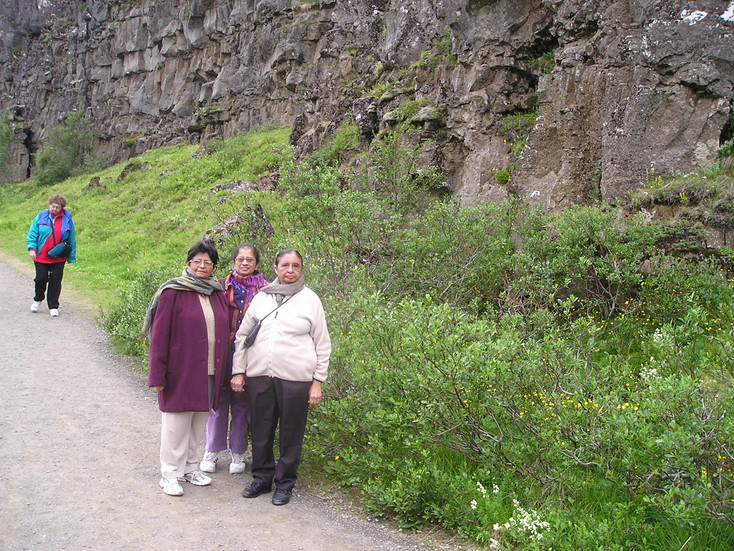ICELAND - 2006
- Usha Shah
- Aug 26, 2024
- 3 min read
Updated: Mar 11
We were planning to go to Iceland on our way to USA. One of our friend had done this trip recently with a group. So we followed the same itinereary. It was not a very lengthy trip and that suited us perfectly. From Mumbai we flew to London, and from there onto Iceland. This destination gave us a possibility to fly directly from there to USA.
The tour was called ‘ ICELAND Complete ’.
Iceland is a Nordic island nation in the North Atlantic Ocean, known for its dramatic landscapes of volcanoes, geysers, hot springs, and lava fields. Iceland's geologic activity includes geysers and frequent volcanic eruptions.
Iceland sits on the Mid-Atlantic Ridge. As a result it is the most active volcanic regions in the world, with around 30 active volcanic systems. Vatnajökull, Europe’s largest ice cap covers multiple volcanoes, including Grímsvötn, one of Iceland's most active volcano.
Glaciers cover about 11% of the country.

On arrival we stayed at a hotel in Reykjavík. Our tour was to start next morning.
We were picked up from the hotel next morning. We started from the capital city Reykjavík. Most of the population lives in the capital, Reykjavik, which runs on geothermal power. The tour takes you around the full circle along the coastal route. Some tours take clockwise route and others anticlockwise.The route goes along the coast of the island.
Basically what you see is volcanoes , glaciers, and innumerable water falls - each one different from the other.
The interior consists of a volcanic plateau characterised by sand and lava fields, mountains, and glaciers, and many glacial rivers flow to the sea through the lowlands. Iceland is warmed by the Gulf Stream and has a temperate climate, despite a latitude just south of the Arctic Circle. Its high latitude and marine influence keep summers chilly, and most of its islands have a polar climate.

(Thingvellir) is a historic site and national park in Iceland, east of Reykjavík. It's known for the Alþing (Althing), the site of Iceland's parliament from the 10th to 18th centuries. On the site are the Þingvellir Church and the ruins of old stone shelters. The park sits in a rift valley caused by the separation of 2 tectonic plates, with rocky cliffs and fissures like the huge Almannagjá fault.
On first day we reached an area of lava field - walked through this valley. Hot water springs in this area provide heated water all over Reykjavík. Almannagja’s cliffs and fissures symbolised the physical separation of the continents, reflecting Iceland’s place at the meeting point of worlds, both geographically and culturally.
Visitors can walk through this historic gorge, where Iceland’s democratic traditions began while marveling at the tectonic forces that continue to shape it.

Seljalandsfoss Waterfall: A waterfall you can walk behind. Seljalandsfoss is a beautiful waterfall along the southern coast. It cascades over steep cliffs, which makes it possible for you to walk behind the waterfall. You will get a spectacular view of the waterfall itself and the surroundings.
In the evening we stayed at a small town Selfoss is a town in southern Iceland on the banks of the Ölfusá river.
Skógafoss Waterfall: Next day we reached Skogafoss waterfall. Famous for its rainbows on sunny days.

Jökulsárlón Glacier Lagoon: We stayed near Jökulsárlón. Floating icebergs and boat tours.

Skaftafell National Park
From here we reached the magnificent falls of Gullfoss, where a wide, 2-tiered wall of water tumbles into a narrow gorge.
Gullfoss is a waterfall located in the canyon of the Hvítá river in southwest Iceland. The waterfall Gullfoss & the erupting hot spring Geysir are two of Iceland's nature sights that every visitor should see.

In the evening we stayed at a small town.Selfoss is a town in southern Iceland on the banks of the Ölfusá river.
The Blue Lagoon is a geothermal spa in southwestern Iceland. The spa is located in a lava field 5 km from Grindavík and in front of Mount Þorbjörn on the Reykjanes Peninsula, in a location favourable for geothermal power, and is supplied by water used in the nearby Svartsengi geothermal power station.




















Comments